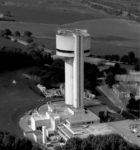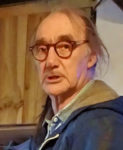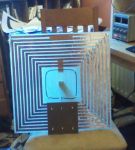Colin Horrabin, G3SBI, November 2020
Colin Horrabin, G3SBI, passed away in the last weekend of November 2020, a month after being diagnosed with cancer. He did not respond to treatment and passed away at home.

NSF tower, Daresbury Labs. Image: cc-by-sa-2.0-Science and Technology Facilities Council (UK).
Colin worked at Daresbury Nuclear Physics Laboratory. He was responsible for numerous innovations, including the “superb” serial link control system for the Nuclear Structure Facility (NSF) – the iconic 70m tower at the Lab.
He had a long and happy retirement during which he pursued many projects, most of which involved amateur radio. He invented the H Mode Mixer, which among many other uses was the heart of the CDG2000 high performance transceiver he co-designed with Dave, G8KBB and George, G3OGQ that was published in a series of RadCom articles and won the Ostermeyer Trophy in 2003. Another RSGB award bestowed on him was the Bennett Prize (in 1994).
For decades he also had a passionate interest and much design skill in low phase noise oscillators, which are crucial for close-in dynamic range performance. He was latterly a proponent of the ‘double-tank’ oscillator that used two resonant elements in a kind of stability push-pull arrangement. Other amateur interests included antennas, including a novel, very compact, flat spiral multi-band HF antenna that he often used when out portable. Colin’s final major project was a portable all-mode all-band HF to UHF transceiver he called the GADAT that, sadly, he did not have time to develop beyond a detailed block diagram and mechanical prototype.
Beyond amateur radio, Colin was a keen woodworker and DIY enthusiast.
Colin maintained a lively technical correspondence by email and telephone with numerous people around the world and was not above speaking truth as he saw it to power, as several Members of Parliament would attest.
Colin leaves his wife of many years Helen, plus their children and grandchildren.
Colin’s funeral was on 9 December 2020. According to someone who attended, it was
“…a non-religious affair; the music was ‘Hey Jude’ and ‘Imagine’. The main focus of the chat was double tank oscillators and the H-Mode Mixer, also the CDG2000 and the GADAT receiver designs. Colin was a brilliant engineer who made huge contributions to the world of particle accelerators in both the Nuclear Structure Facility (NSF) and the Synchrotron Radiation Source (SRS).
“After the service I followed Helen and his daughters back to the beautiful cottage where Colin had lived and loved for the final part of his life. True to form, in the front garden was the recently-ordered metalwork for his latest project and Helen complained that he even had an aerial in the bathroom!
“Helen asked for any donations to be made to Cancer Research UK.”
RIP Colin.
Extract from private correspondence written by Colin Horrabin in February 2018 that includes some interesting biographical details. It gives some insight into his character and the wide range of his interests.
“I hate writing about anything I have done because when I worked at DL [Daresbury Labs – Ed] I would always move on to something else of interest so I usually had to be ordered to write something for a particular conference or other.
“When it became obvious that the HF7070 was not going to get into production I became concerned the important design ideas would be lost so I decided I would do a write up for RadCom. I started to do the write up and kept throwing bits of paper in the bin. I am incredibly modest about my technical achievements and I can’t use the letter ‘I’ it embarrasses me and I couldn’t write in the first person.
“One of the bits of instrumentation I designed in 1968 to try and understand what happened in Van De Graff accelerators when you had high voltage flash over was a capacitive divider plus high impedance amplifier that had a division ratio of around 100,000 so that a 100,000 volt signal between a plate separated by only 1 inch could become a few volts for the FET input amplifier which was used as a high input impedance X 1 buffer amplifier. This had a bandwidth of a few kHz (so we could calibrate it) to 500MHz. A simple capacitance divider is just a plate stuck in the field but that meant the plate had to be one thousand of an inch above ground, an almost impossible job. One way to increase the division ratio was to have a small hole in the ground plane and on the other side a large plate to increase the capacitance division. I never leave anything to chance so I made up a strip line one inch apart along which to pass known signals shapes at lower voltages and looked at the output and the ‘hole in the ground plane’ technique lied and caused ringing. The design study team on the project was multi discipline and we all got on well. I was talking to Tom Charlesworth at out coffee school about the problem (Tom was an applied physicist and had an HNC not a degree but he was very resourceful). I had already found out if I used a standard anodised front panel and sprayed a silver paint electrode on it told the truth but I could only get a division ratio of 10,000 to 1. However Tom knew that our stores had some very finely finished tear-off aluminium strips normally used for packing joints. So we anodised one of these ourselves and the silver paint job did the trick. What we found out using this was really important so I wrote a TM and I told Tom I was making him a co-author. He protested about this because he thought the electronics was the fancy bit. However I wrote it and as ‘C’ comes in the alphabet before ‘H’ it was his paper!
“I realised I was never going to be able to write about the HF7070 until I took a leaf out of the way Pat Hawker wrote in TT. If you write in the 3rd person it is easy to bring in other people’s contributions. How it came to be in QEX was that I got into an email exchange with Joel Hallas the technical editor of QST about IP3 in crystal filters and wound up sending it to him. I got a reply saying that it was the most interesting thing he had ever read about communications receiver design can we use it in QEX. So the editor of QEX, Larry Wolfgang, had to convert it to first person and I liked the result.
“The reason the article on the double tank oscillator appeared in QEX is that Martein, PA3AKE told me about a new software package Analog devices had produced to calculate PLL performance and they did not know Leeson’s equation could be beaten so I wrote this on a need to know basis .This time I manged to write it in the 1st person.
“I learnt my radio from American textbooks and when I started the electrical engineering course at the then Royal College of Advanced Technology Salford. The recommended textbooks were all by American authors the reason being that they were easy to read in imparting knowledge rather than the author wanting to show you how clever he is. QEX has a relaxed format and they printed what I wrote including tongue in cheek jokes ‘like a piece of cake’ in my later article on the high performance 45 MHz amplifier.
“Some contributors to RadCom seem to forget that it is a hobby magazine and not a formal professional technical publication and that is unfortunate as in my opinion technical articles need to be ‘casual’. One of the problems today is interesting young people in the technology of radio receivers. So in my opinion you have to write in a way that excites their imagination enough to want to go and find out in more detail about it. I well remember reading about Alan Blumlein who invented stereo and 405 line electronic TV before WW2 and was the brains behind H2S radar. He was considered a failure at school because he didn’t learn to read until he was 13 years old. However he then picked up a book on electrical engineering and he was hooked. It couldn’t have been any old book it must have been written in such a way that it interested him.
“One of the designers of the CDG2000, George Fare, was 10 years my senior and he died a couple of years ago from cancer. By Profession he was a surveyor but I would give him a job in electronics anytime. He was one of these people who could become an expert in anything and like me amateur radio had played an important part in his life. When we designed the CDG2000 it was he that insisted we had to do it in such a way it was easy for other constructors to make it. His wife hates me because at a meal I criticised Thatcher for what she did to our engineering industry with her high interest rate policies (OK if you have money and you get 20% interest for doing nothing). George’s daughter had never met me until his funeral at Royal Leamington Spa and being a big wheel in the City seemed to be of the same opinion. She seemed surprised that Dave Roberts and I were the only people present from Warrington and none of his Masonic friends were there. I said to her it’s a long way to travel and that it may seem in view of the circumstances a macabre thing to say but only death would prevent me from attending your father’s funeral. I remember George saying to me that he thought he had a lot of friends but he found out who his real friends were when they knew he had cancer.
“I felt a normal sort of obituary would be inappropriate to George so I have been working on and off, DIY permitting, on an article tongue in cheek and casual called ‘An Ode to Q’, which I intend to dedicate to George. If you don’t realise it, Q is the most important thing in a radio receiver and it was first really used in the early broadcast superhet receivers that took off in the USA. The superhet developed quickly in the USA because every town wanted a radio station. To make use of the available frequency space on medium wave a superhet receiver had to be used to enable stations to be 20 kHz apart. Our old friend Q assisted in this because if the maximum Q you could get from a tuned circuit of the day was 100, an IF of 455 kHz meant that 5 kHz bandwidths were possible.
“You know how the Americans hate it when the Brits show them how to do it. Well a number of them have said that in their opinion the double tank oscillator is the most important technical development since Armstrong developed the Superhet receiver. Also that the two QEX articles about the design of the HF7070 and the double tank oscillator are the most important articles ever written about communication receiver design.”
Category: Silent Keys












